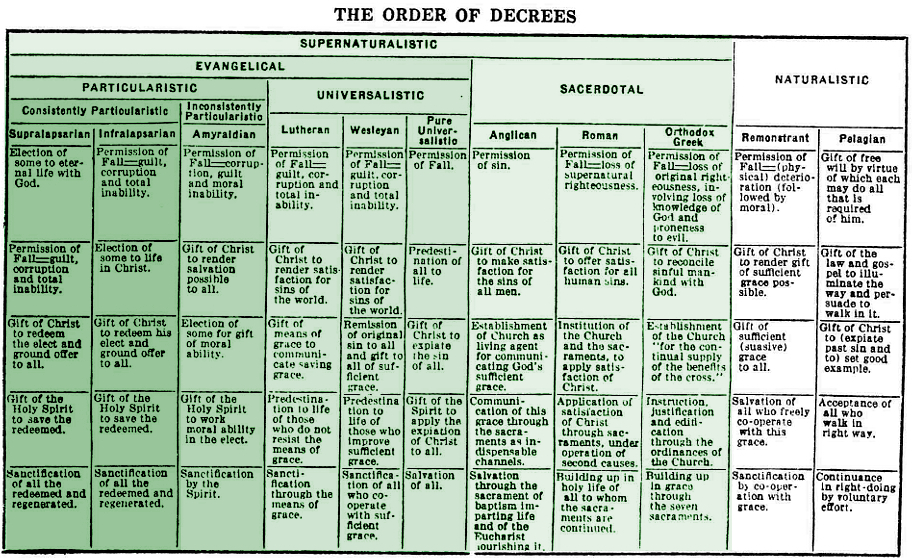B. B. Warfield's famous "The Order of Decrees" chart from The Plan of Salvation is figured above. I've colorized the chart so that the darkest swim lanes are those most endorsed by B. B. Warfield (and most exemplifying Rationalistic Calvinism.)
George Hunsinger referenced B. B. Warfield's famous "Orders of Decrees" chart (see figure above) in a footnote of his recent book: Reading Barth With Charity: A Hermeneutical Proposal. Warfield's chart is famous and influential, and the following footnote caused me to have a paradigm shift regarding it, because I once saw it as the clearest assessment of Calvinism's superior Plan of Salvation, but now I understand it as symptomatic of Rationalistic Calvinism:
An interesting chart drafted by B. B. Warfield unwittingly reveals so much of an outlier rationalistic Calvinism has been within the context of World Christianity. See Warfield, The Plan of Salvation (Grand Rapids: Eerdmans, 1980, 30.)
Hunsinger, George. Reading Barth with Charity: A Hermeneutical Proposal. Grand Rapids: Baker Academic, 2015. Xiv-Xv. Print.
B. B. Warfield devised this famous "Orders of Decree" chart in his small book, The Plan of Salvation. Warfield's endorses only the "Consistently Particularistic" plans for salvation that include the Supralapsarianism and Infralapsarianism swim lanes in the chart. Warfield believes all the Reformed Creeds are more-or-less Infralapsarian, but Supralapsarian is not explicitly excluded as an orthodox option by these numerous sixteenth and seventeenth century Reformed Creeds. Warfield places the "Consistently Particularistic" columns in juxtaposition to all other forms of Calvinism and Christianity listed in the swim lanes (with those increasing in heterodoxy to the right). Amyraldism (or as Warfield calls it, "Hypothetical Universalism") is listed within the "Particularistic" parent swim lane, however, Warfield discretely dismissed Amyrauldism as an "a logically inconsistent form of Calvinism and therefore an unstable form of Calvinism."
What is Rationalistic Calvinism, and how does it differ from non-Rationalistic Calvinism (i.e. Evangelistic Calvinism)? B. B. Warfield is only a footnote to this question, that Hunsinger aims to answer in Reading Barth With Charity. Although Hunsinger is not directly addressing Warfield (or his chart) in the following quotations, these quotations explain the difference between Rationalistic Calvinism and Evangelical Calvinism.
Hunsinger uses T. F. Torrance's definition of Evangelical Calvinism:
Evangelical Calvinism, as explained by [Thomas F.] Torrance . . . was more biblical and less scholastic. It retained a more open-textured structure as opposed to a fast for sharp distinctions and scholastic rigor. It believed that theological statements pointed away from themselves to the truth about God, which by its nature could not be contained in finite forms of speech and thought, but also that without theological statements, such truth could not be mediated. It judged, according to Torrance, that the filial was prior to the legal, that the personal was prior to the propositional, that the indicative took precedence over the deductive, and that spiritual insight placed constraints on logical reasoning.
Ibid. Xiv-Xv.
Again, Hunsinger uses T. F. Torrance's to define Rationalistic Calvinism:
The priorities of rationalistic Calvinism were more or less the reverse. Rationalistic Calvinism, for Torrance, was associated with Theodore Beza, the Westminster standards (1646-48), and the Synod of Dordt (1618-19). It was known for such extreme outcomes as limited atonement, a debate between "supralapsarianism" and "infralapsarianism," and a legalistic construal of "covenant" that tended towards synergism. These unfortunate ideas reflected a certain mode of reasoning. The legal was prior to the filial, the deductive to the inductive, and the propositional to the personal. There was a general tendency to draw logical conclusions from abstract propositions and to arrange the results in water-tight systems. As Torrance saw it, this type of Calvinism predominated from roughly 1650 to 1950 in the Anglo-Saxon world, especially in Scotland and the United States.
Ibid. Xv.
And in this last quotation, Hunsinger compares and contrasts Evangelical Calvinists to Rationalistic Calvinists:
Hilary of Poiters . . . might read, "It is not the concepts that dictate the subject matter, but the subject matter that dictate the concepts."
Rationalistic Calvinism tended to reason from the concepts to the subject matter. It argued that certain beliefs must be true because they followed logically from certain abstract propositions. In that sense the subject matter was dictated by the concepts.
Evangelical Calvinism, on the other hand, tended to do the opposite by reasoning from the subject matter to the concepts. It refrained from what it regarded as a false application of logical rigor because of constraints imposed by the subject matter, even if they had to be left in tension.
Rationalistic Calvinists, for example, argued rigorously from double predestination to limited atonement, whereas at least some Evangelical Calvinists resisted those conclusions. Instead they gave priority to scriptural affirmations that Christ died for all, even though they could not resolve all the remaining perplexities. The difference between the two forms of Calvinism was to a significant degree, the difference between deductive and inductive reasoning.
Ibid. Xv-Xvi.
Header Image Source:
Warfield, Benjamin Breckinridge. The Plan of Salvation. Grand Rapids, MI: Wm. B. Eerdmans Pub., 1966. 31. Print.




July 12th, 2015 - 10:46
Excellent post. I have often contended that many of the forms of Calvinism I have encountered (both in contemporary settings and in the study of history) have overly tended toward a form of philosophical rationalism that I find forcing the Scriptures into molds for which the word will not stay. Thanks for sharing the quotes and the chart. It is indeed indicative of the “fringe” nature of such a movement from the wider Church.
July 12th, 2015 - 13:17
Thanks Rick! I agree. It was a excellent observation by George. Fringe is a good word, or isolating tendency too pairs with its nature. Hunsinger takes the rationalistic vs evangelicistic Calvinism a different direction in the book. It’s still a solid point.
July 26th, 2015 - 10:55
Richard Muller blew this thesis out of the water awhile ago.
October 13th, 2015 - 11:34
Not reall, Trent. Muller just argues that rationalistic calvinism has been really the only game in town. Yes Muller has layered things out in PRRD, historically, but Muller does not get it (the critique of TFT or Barth) theologically. Muller is aloof to such things!
October 13th, 2015 - 11:49
Muller doesn’t understand Barth or Calvin.
October 13th, 2015 - 11:33
Great post, Wyatt!
Hey, we’ve noticed this *Evangelical Calvinism* too ;-). I was happy to see Hunsinger highlight TFT’s language of Evangelical Calvinism in his Charity book. Nice!
October 13th, 2015 - 12:07
Thanks Bobby!
October 14th, 2015 - 05:48
Wyatt, this chart really does deserve an exhibit in the Museum of Counterproductive Propaganda.
But why is it entitled Order of Decrees?